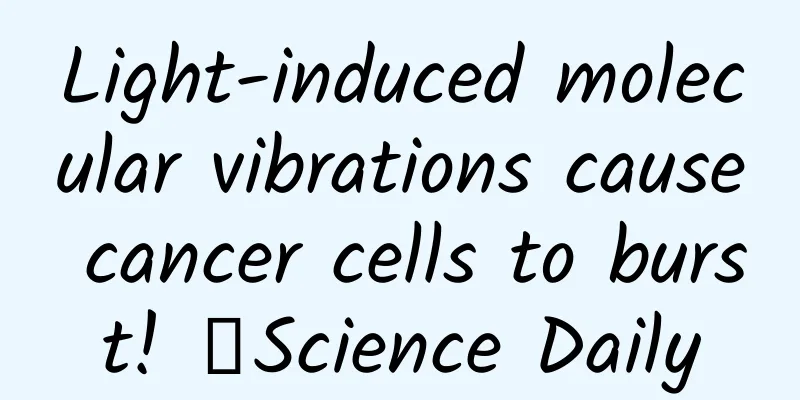Light-induced molecular vibrations cause cancer cells to burst! |Science Daily

|
01 Eliminating antibiotic-resistant “superbugs” A research team from the University of Amherst and its collaborators have discovered a key mechanism that blocks pathogens from infecting host cells and developed a test method to identify the next generation of drugs that target this vulnerable cellular mechanism. The research paper has been published in ACS Infectious Diseases. The typical strategy for treating microbial infections is to bombard the pathogen with antibiotic drugs, which work by entering the offending cell and killing it, but it is difficult to design drugs that are both water-soluble and oil-soluble. Alternatively, pathogenic cells can develop more "efflux pumps" to safely expel antibiotics from the cell and become resistant to that particular antibiotic. In order to penetrate the cell wall of the host cell, the pathogen needs to secrete two proteins, PopD and PopB, and combine them to form a "translation linker" to form a cellular tunnel through the cell membrane. Once the tunnel is established, the pathogenic cell can inject other proteins to complete the task of infecting the host. The whole process is called the type 3 secretion system. Researchers try to disrupt this process to prevent pathogens from infecting host cells without killing the pathogens to prevent them from developing drug resistance. To find molecules that can prevent the formation of "translation junctions", the researchers developed a test method that uses a fluorescent enzyme as a tracer. The researchers split the enzyme into two halves, one half was inserted into the PopD/PopB protein, and the other half was inserted into the host cell. If the host cell suddenly lights up, it means that PopD/PopB has successfully broken through the cell wall and reunited the two halves of the luciferase. If the cell remains in the dark, it will know which molecules have destroyed the "translation junction". The findings could be used to identify new drugs that can neutralize pathogens, leading to real improvements in public health. Paper link: https://pubs.acs.org/doi/10.1021/acsinfecdis.3c00482 02 The study found that: Sleeping is also learning, breathing consolidates memory A study from a team at the University of Munich found that breathing is a potential pacemaker that affects the consolidation of memory during sleep. The research paper was published in Nature Communications. The researchers showed 120 pictures to 20 participants in two sessions. All the pictures were associated with specific words. The participants then slept for about two hours in a sleep lab and when they woke up, the researchers asked them about their associations. Throughout the learning and sleep process, the participants' brain activity and breathing were recorded by electroencephalogram. The researchers found that the sleeping brain spontaneously reactivated previously learned content during the appearance of so-called slow oscillations and sleep spikes (brief phases of increased brain activity). The study also found that breathing was associated with the appearance of characteristic slow oscillations and spindle patterns, and breathing was also important for memory processing during sleep. Paper link: https://www.nature.com/articles/s41467-023-43450-5 03 The "Death Star" isomerization sites were fully identified. May help cancer drug development A study from Spain and the UK has comprehensively identified isomeric sites in the protein KRAS, providing the first complete KRAS control map, which will help cancer drug development. The study was published in Nature. KRAS is one of the most commonly mutated genes in many types of cancer. It has been called a "Death Star" protein because of its globular shape and lack of drug targets. The only effective strategy to control KRAS is to target its allosteric communication system. To control a protein, you need a key (a compound or drug) that opens a lock (the active site). Proteins can also be affected by auxiliary locks (allosteric sites) located elsewhere on their surface. When a molecule binds to an allosteric site, it causes the protein to change its shape, which can alter the protein's activity or its ability to bind to other molecules. Allosteric sites are often the first choice for drug development because they are more specific and less likely to cause side effects. They can also more subtly change the activity of a protein, providing the possibility of fine-tuning its function. Drugs targeting allosteric sites are generally safer and more effective than those targeting the active site. However, allosteric sites are very elusive, and only two drugs have been approved for clinical use in four decades of research. This study used a technique called deep mutational scanning to map these isomeric sites and found that KRAS has more strong isomeric sites than expected. The study also found that some of the sites located in four different pockets that are easily accessible on the protein surface are promising drug targets in the future, which will help design safer and more effective drugs. Paper link: https://www.nature.com/articles/s41586-023-06954-0 04 Light induces molecular vibrations, causing cancer cells to burst! A Rice University study published in Nature Chemistry has found a way to destroy cancer cells by exploiting the ability of certain molecules to vibrate strongly when stimulated by light. Researchers have found that the atoms of a small dye molecule used in medical imaging vibrate in unison when stimulated by near-infrared light - forming so-called plasmons - which can cause the cell membranes of cancer cells to rupture. The molecule is an aminocyanine, a class of fluorescent synthetic dyes used in medical imaging. Paper link: https://www.nature.com/articles/s41557-023-01383-y 05 Science : Candidate materials for the world's first high-temperature superconducting diode For decades, superconducting materials, which allow electrons to flow flawlessly, have generally exhibited this quantum mechanical property only at temperatures just a few degrees above absolute zero, making them impractical for practical use. Using a unique method of low-temperature device fabrication to create and manipulate a widely studied class of high-temperature superconductors, cuprates, a Harvard study has discovered a candidate material for the world's first high-temperature superconducting diode - essentially, a switch that enables current to flow in one direction - made from thin cup-shaped crystals. The research paper was published in Science. Using an air-free cryogenic crystal manipulation method in ultrapure argon, the researchers engineered a clean interface between two extremely thin layers of bismuth strontium calcium copper oxide (“BSCCO”). BSCCO is considered a high-temperature superconductor. The researchers first separated the BSCCO into two layers, each only one-thousandth the width of a human hair. Then, at minus 130 degrees, they stacked the two layers on top of each other in a 45-degree twist, like making an ice cream sandwich with skewed wafers, preserving superconductivity at the fragile interface. The researchers found that the maximum supercurrent that can pass through the interface without resistance varies depending on the direction of the current. Most importantly, the researchers also demonstrated electronic control of the quantum state of the interface by reversing this polarity. It was this control that allowed the researchers to effectively create a switchable, high-temperature superconducting diode. Paper link: https://www.science.org/doi/10.1126/science.abl8371 06 New superconducting material can be turned on or off A University of Washington study published in Science Advances has discovered a superconducting material that is uniquely sensitive to external stimuli, allowing its superconducting properties to be enhanced or suppressed at will. Superconductivity is a quantum mechanical phase of matter in which electric current can flow through a material with zero resistance. The material discovered in the study consists of a slab of ferromagnetic europium atoms sandwiched between superconducting layers of iron, cobalt and arsenic atoms. The material's multiple phases compete closely with each other, and by applying a tiny strain or magnetic field, one phase can be made to outperform the other, turning the superconducting function on or off. The material could lead to more efficient large-scale computing and could also be used in superconducting circuits for the next generation of industrial electronics. Paper link: https://www.science.org/doi/10.1126/sciadv.adj5200 07 Cardiac vests can predict sudden cardiac death risk A vest that maps the heart's electrical activity in detail could potentially be used to better identify people at high risk of sudden cardiac death, according to a study from University College London published in the Journal of Cardiovascular Magnetic Resonance. Electrical data from the 256 sensors on the ECGI vest can be combined with detailed images of the heart's structure taken by magnetic resonance imaging (MRI) to generate a 3D digital model of the heart and the waves of electrical activity flowing through it. The vest is reusable and time-saving, taking only five minutes, so it has the potential to be used as standard of care. The study evaluated the feasibility of the vest in 77 patients and found it to be reliable and durable. Since then, the vest has been successfully used in 800 patients. The vest is currently being used to map the hearts of patients with diseases such as hypertrophic cardiomyopathy and dilated cardiomyopathy. The vest could be a rapid, cost-effective screening tool to help people better identify their risk of life-threatening heart rhythms in the future, and could help assess the effects of medications, new cardiac devices and lifestyle interventions on heart health. Paper link: https://www.ucl.ac.uk/news/2023/dec/heart-vest-could-help-predict-sudden-cardiac-death-risk 08 The study found that: AI can predict when a person will die A Danish study published in Nature Computational Science found that artificial intelligence can analyze registry data about people's place of residence, education, income, health and working conditions, and predict life events with high accuracy, and even estimate the time of death. The researchers analyzed health data and labor market attachments of 6 million Danes in a model called life2vec. Life2vec encodes data into a large system of vectors, a mathematical structure that organizes different data. The model decides where to put data about birth time, schooling, education, wages, housing and health. After an initial phase of training the model, it outperformed other state-of-the-art neural networks and was able to predict outcomes such as personality and time of death with high accuracy. Of course, there are also some ethical issues surrounding the life2vec model, such as protecting sensitive data, privacy, and bias in the data, and these challenges must be understood more deeply. The researchers believe that the next step will be to incorporate other types of information, such as text and images or information about our social relationships. The use of data opens up entirely new avenues of interaction between the social sciences and the health sciences. Paper link: https://www.nature.com/articles/s43588-023-00573-5 09 Nature : Artificial intelligence generates proteins with super strong binding ability A study from the University of Washington School of Medicine published in Nature used software to create protein molecules that bind with extremely high affinity and specificity to a variety of challenging biomarkers, including human hormones. This study introduces a new protein design approach using advanced deep learning methods, combining RFdiffusion, a generative model for creating new protein shapes, with ProteinMPNN, a sequence design tool. By combining these tools in a new way, the researchers generated binding proteins using limited target information, such as the amino acid sequence of a peptide. The advance could enable scientists to develop cheaper alternatives to antibodies for disease detection and treatment. Paper link: https://www.nature.com/articles/s41586-023-06953-1 10 Artificial intelligence unveils the mystery of polycrystalline materials Polycrystalline materials are widely used in information devices, solar cells and electronic devices. A major problem in using polycrystalline materials in industry is that stress and temperature changes can form tiny crystal defects. These defects, called dislocations, disrupt the regular arrangement of atoms in the crystal lattice, affecting electrical conductivity and overall performance. A research team from Nagoya University in Japan has used artificial intelligence to discover a new way to understand dislocations in polycrystalline materials. The research was published in Advanced Materials. The research team used a new type of artificial intelligence to analyze image data of a material widely used in solar panels (polycrystalline silicon). The artificial intelligence created a three-dimensional model in virtual space, which helped the researchers identify areas of dislocation clusters that affect the material's performance. After identifying the areas of dislocation clusters, the researchers used electron microscopy and theoretical calculations to understand how these areas are formed. They revealed the distribution of stress in the lattice and found step-like structures at the boundaries between grains. These structures appear to be the cause of dislocations during crystal growth. This research points the way to establishing universal principles for high-performance materials and is expected to contribute to the creation of innovative polycrystalline materials, potentially even bringing revolutionary changes to society. Paper link: https://onlinelibrary.wiley.com/doi/10.1002/adma.202308599 11 VideoPoet: A Large Language Model for Zero-Shot Video Generation Recently, Google launched the Large Language Model (LLMs) VideoPoet, which can complete a variety of video generation tasks, including text to video, image to video, video stylization, video in- and out-picture, and video to audio. Recently, there has been a wave of video generation models that have shown amazing capabilities in many cases. One of the current bottlenecks in video generation is the ability to generate coherent large-scale actions. Compared to other models in this field, VideoPoet seamlessly integrates multiple video generation capabilities in a single LLM, rather than relying on components trained separately for each task. Specifically, images fed into VideoPoet can be animated to produce motion effects, and videos (optionally cropped or masked) can be edited by inpainting or outpainting. In terms of stylization, the model takes in videos representing depth and optical flow (representing motion) and paints content on top to produce a text-guided style. Paper link: https://www.nature.com/articles/s41467-023-43445-2 |
<<: Special: Mountains and rivers are wallpapers everywhere
>>: He tried to hold back a sneeze and ended up tearing a hole in his trachea | BMJ Case Reports
Recommend
Amid the proliferation of copycat giants: A survey of the domestic VR ecosystem
Introduction It is worth noting that BAT has also...
Dafeng SEO Training: How to optimize SEO keyword rankings? How to improve connection quality?
SEO is an inductive science, which cannot be expl...
Musk's plan to control the human brain has taken another step forward. Westlake University has developed a 1 square millimeter neural chip. Are you ready to install a chip in your brain?
The girl, with only her brain intact, was revived...
Sharing of Douyin's highly profitable money-making project: Douyin snack training monetization project, with profits exceeding a thousand for one order!
The project that I will be dissecting for you tod...
The road to "customized marketing" for online education in 2020
The battle for customer acquisition in online edu...
How can newbies quickly become familiar with WeChat public account operations?
This article discusses four major aspects: famili...
7 major channels for promoting Douyin and increasing followers!
If it is an enterprise account, it is recommended...
Lighthouse permissions are open, is open source technology the future of VR?
Abstract: There are many examples of open source ...
The less bad cholesterol, the better, and the more good cholesterol, the better? In fact, this range is more appropriate!
With the popularization of health knowledge, many...
You think the sea is blue? Actually, your eyes deceive you.
Is the ocean really blue? In a study published in...
Skyworth CEO Yang Dongwen: Box is a sunrise industry, the next wave is TV games
Last Friday, Skyworth Group CEO Yang Dongwen said ...
IEA: Hydrogen Monitoring Report for Northwest Europe 2024
Northwest Europe is at the forefront of low-emiss...
Collection: 68 information flow ads and SEM learning website resources are available for free!
01. CNZZ -UDplus Website: udplus.umeng.com Note: ...
Private tips on how to place game information streams, told to you for free!
Before reading this article, we need to have a co...
Where is the trigger point for smart homes that are cold on the outside but hot on the inside?
Recently, the "2014 China Building Materials...









